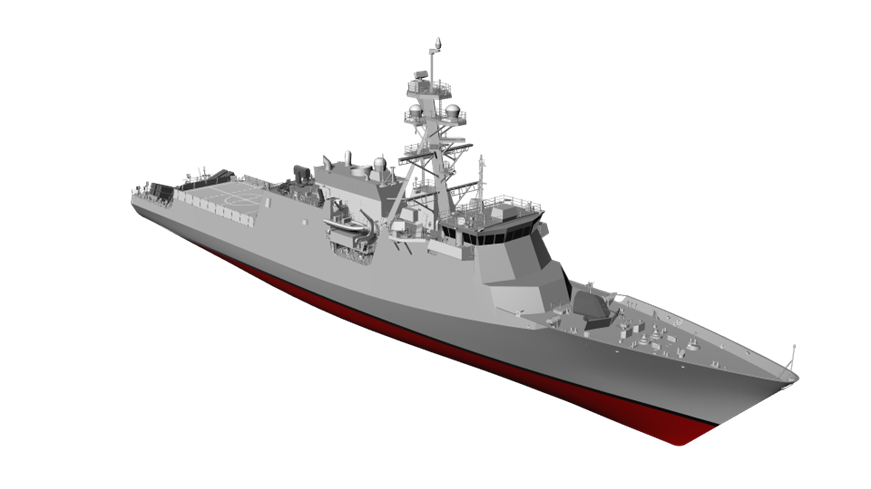Halifax Tar
Army.ca Legend
- Reaction score
- 17,164
- Points
- 1,260
Works for me!

Because the National Security Cutter design fundamentally isn't what the USN exactly wants, given it has limitations in the kind of sensor and weaponry suite it can fit without very extensive upgrading. It can likely fit something like 16 cells, no AEGIS and a less capable sensor suite in comparison to what they wanted Constellation to do as well.

The Golden ‘White House’, Golden Dome and now the Golden Fleet. Where’s Gold Member ? At the 2min mark the Admiral could have been talking about Constellation class before Navsea decided to change everything. 2:26 Halifax class centre screen.Meanwhile the US pivots once more on their frigate program. I suspect that any "Good idea fairy" in the vicinity will be shot on sight.

SECNAV: New Frigate will be Based on National Security Cutter, First FF(X) to be Built at Ingalls - USNI News
This post has been updated with a rendering of the proposed FF(X) design. The U.S. Coast Guard Legend-class will serve as the basis of a new Navy frigate program, Secretary of the Navy John Phelan and Chief of Naval Operations Adm. Daryl Caudle announced on social media Friday. Following last...news.usni.org
You forgot the new Gold Card - for 1$ million USD you too can immigrant to the US, as long as your not for the list of 26 identified countries.The Golden ‘White House’, Golden Dome and now the Golden Fleet. Where’s Gold Member ? At the 2min mark the Admiral could have been talking about Constellation class before Navsea decided to change everything. 2:26 Halifax class centre screen.
Its a very ruff first draft, but I see a 57mm, a RIM-116 RAM, 2 quad NSM box launchers, and what looks like an SG-AMB radar. So, a anti-surface warfare platform that can do some very limited point defense AAW. I can't see any torpedo tubes. Curious if there is enough space for a CAPTAS.Meanwhile the US pivots once more on their frigate program. I suspect that any "Good idea fairy" in the vicinity will be shot on sight.

SECNAV: New Frigate will be Based on National Security Cutter, First FF(X) to be Built at Ingalls - USNI News
This post has been updated with a rendering of the proposed FF(X) design. The U.S. Coast Guard Legend-class will serve as the basis of a new Navy frigate program, Secretary of the Navy John Phelan and Chief of Naval Operations Adm. Daryl Caudle announced on social media Friday. Following last...news.usni.org
In naval service, the Trump-class frigate?The Golden ‘White House’, Golden Dome and now the Golden Fleet. Where’s Gold Member ? At the 2min mark the Admiral could have been talking about Constellation class before Navsea decided to change everything. 2:26 Halifax class centre screen.
I expect that USS Kennedy will be renamed USS Donald J Trump at commissioning. Can’t have it named after a Democratic president.In naval service, the Trump-class frigate?
Would lend a new meaning to 'serving in her' vs 'serving on her'.I expect that USS Kennedy will be renamed USS Donald J Trump at commissioning. Can’t have it named after a Democratic president.
The frigate naming: USS Ivanka, Ivana, Marla, Melania, Tiffany, Ghislaine, Jeffrey, Don Jr, Eric, Barron….
What, no USS STORMY??I expect that USS Kennedy will be renamed USS Donald J Trump at commissioning. Can’t have it named after a Democratic president.
The frigate naming: USS Ivanka, Ivana, Marla, Melania, Tiffany, Ghislaine, Jeffrey, Don Jr, Eric, Barron….
They do want swap-able mission containers. This honestly looks like a super cut down in capability from the Constellation. No integral VLS, no integral ASW. Make sense if they want to build the thing in 3 years (2028 is what they were saying), the HFX class seem more capable at this point.Its a very ruff first draft, but I see a 57mm, a RIM-116 RAM, 2 quad NSM box launchers, and what looks like an SG-AMB radar. So, a anti-surface warfare platform that can do some very limited point defense AAW. I can't see any torpedo tubes. Curious if there is enough space for a CAPTAS.
If they want quick and dirty, one trick ponies, this is it. they’ve put themselves into a shipbuilding corner. Almost as bad as us (adjusted for global interests).They do want swap-able mission containers. This honestly looks like a super cut down in capability from the Constellation. No integral VLS, no integral ASW. Make sense if they want to build the thing in 3 years (2028 is what they were saying), the HFX class seem more capable at this point.
Yah, we started from much further behind as well. We've gotten our legs under us now, with multiple Coast Guard vessels and AOPV's built, JSS in fitting out and a second about 50% done. But its a long marathon to go.If they want quick and dirty, one trick ponies, this is it. they’ve put themselves into a shipbuilding corner. Almost as bad as us (adjusted for global interests).
Would the Halifaxes be (as far as design goes, not the "rode hard, put away wet" current state) better blue-water ships, too? I know the USCG gets out there, but are deep-sea operations central to their design concept?They do want swap-able mission containers. This honestly looks like a super cut down in capability from the Constellation. No integral VLS, no integral ASW. Make sense if they want to build the thing in 3 years (2028 is what they were saying), the HFX class seem more capable at this point.
The Golden ‘White House’, Golden Dome and now the Golden Fleet. Where’s Gold Member ?



